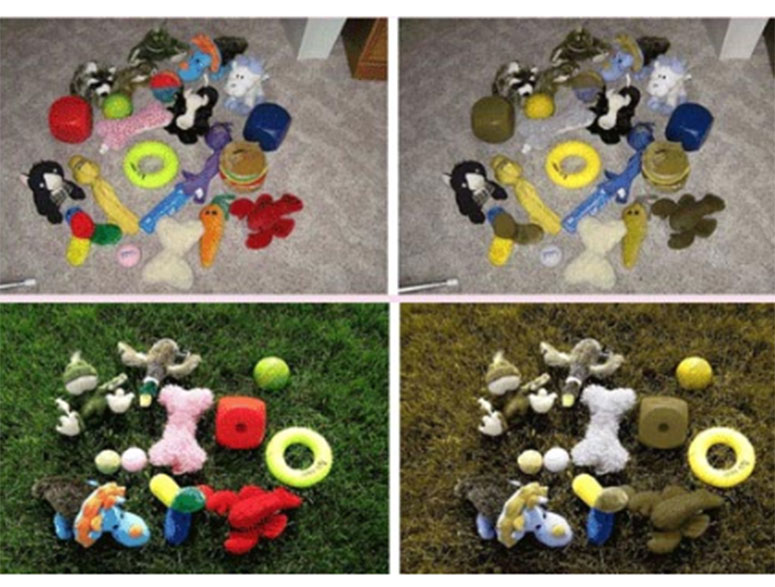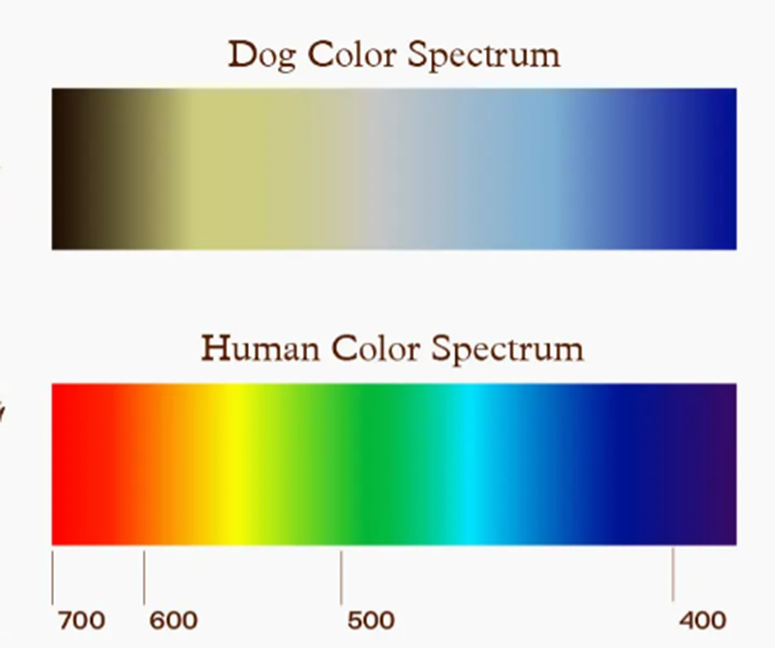Key Takeaways
- Dogs can see some colors, but not in the way humans do.
- Knowing how a dog’s eyes function helps you care for their health.
- Dogs make up for less-than-optimal eyesight with their far superior sense of smell and hearing.
For years, scientists believed dogs lived in a world painted in black and white. However, ongoing research into canine vision has unveiled a more colorful reality, although less vibrant than the human experience.
The belief that dogs could only see shades of grey was finally debunked in 1989 when an ophthalmologist and his colleagues discovered that canines could see blues and yellows but not reds and greens.
Dogs see colors, but their perception of the spectrum differs significantly from ours due to their unique eye structure. Besides satisfying our curiosity, understanding what colors dogs can see and which are beyond their perception improves their care, especially concerning their eye health as they age.
What colors do dogs see?
Dogs are dichromatic, meaning they have two types of color receptors or cones in their eyes, compared to the three types in humans. Scientific American says this makes them similar to most mammals—including cats, cows and pigs.
This difference drastically limits the range of colors dogs can distinguish. What we perceive as red appears as a dark brownish-gray or black to a dog, and green, orange, and bright red all tend to blend into one. Imagine the world’s hues at dusk, and you might get close to how your furry friend sees the world. This experience is similar to what a person with red-green color blindness would see.
The social media app TikTok offers a dog vision filter that many pet parents have used to see how their dog views the world. Several users posted videos of their dog’s toys with the filter on and saw why their dog prefers blue toys to red or green objects.
How good is a dog’s vision in other ways?
A dog’s eyesight is not all that great in general, at least compared to humans. If you’re trying to imagine the world through your dog’s eyes, you should picture everything a lot blurrier, according to the American College of Veterinary Ophthalmologists (ACVO). Most dogs have 20/75 vision, meaning that if they were 20 feet away from an object, they would see it like a human would standing 75 feet away.
A dog’s visual advantages over human vision
But dogs have evolved to have superior vision in some circumstances. Humans see poorly in low light, while canines possess a unique eye structure that helps with night vision – which is six times better than humans. Scientific American says that the canine eye includes a feature that reflects light, which is why your pet’s eyes glow in photos and in the dark. A dog’s retina also has more rods than a person’s, and rods work best under low-light conditions and are good at picking up movement. Another way canines have better vision is in their wider field of view. Since most dogs’ eyes are placed wider apart on the face than the eyes of humans, they have a greater ability to scan the environment and pick up sudden movement, ACVO says. That may be why your dog spots a fleeing squirrel before you do.

How to adjust for your dog’s color blindness
A dog’s partial colorblindness is not really a problem for them – especially since they rely so much on their sense of smell and hearing, both far superior to humans.
However, the limitation means that certain toys, especially red or green ones, might not stand out against the green grass of your backyard in your dog’s vision. Some dogs may like the challenge of identifying a red toy by its other features – smell, shape, and size. If your dog seems frustrated at trying to find a red or green object, consider opting for toys in shades of blue or yellow.

How to protect your dog’s eye health as they age
Just like humans, dogs can experience changes in eye health with age. Conditions such as cataracts, glaucoma, and dry eye can affect their vision and, in some cases, lead to blindness. Regular veterinary check-ups can help catch these conditions early on, and certain dietary choices can also support eye health. If your dog shows signs of having trouble with sight, your regular vet may refer you to a veterinary ophthalmologist. Since they cannot read eye charts and respond, animals’ eyesight cannot be measured using standard human vision tests, says veterinarian Dr. Jeffrey Bowersox of ACVO. Instead, a veterinary ophthalmologist will closely evaluate the health of your dog’s eyes and can even use a series of lenses and a device called a retinoscope to measure nearsightedness and farsightedness.
One study showed that certain breeds, including beagles, terriers, and German shorthair pointers, are predisposed to certain types of eyesight problems such as glaucoma and cataracts. Your veterinarian or veterinary ophthalmologist may recommend more frequent eye exams based on your dog’s breed or health history.
Certain dietary choices can also support eye health. Antioxidants like vitamins C and E, found in many fruits and vegetables, can help protect your dog’s eyes. Omega-3 fatty acids, often found in fish oil supplements, are also beneficial for maintaining healthy vision. Ask your veterinarian if your dog could benefit from a nutritional supplement since supplementing an already balanced diet can lead to problems.
In addition to a nutritious diet, minimizing direct exposure to bright light and ensuring your dog doesn’t injure their eyes can contribute to long-term eye health. Consider outfitting your dog with a pair of sporty goggles if they spend a lot of time outdoors and could benefit from eye protection.
Conclusion
Understanding how dogs perceive the world through their eyes opens up a pathway to deeper empathy and care for our canine companions. By choosing toys that align with their visual capabilities and taking proactive steps to support their eye health, we can enrich their lives and ensure they enjoy a vibrant world, even if it’s a little different from the one we see.


